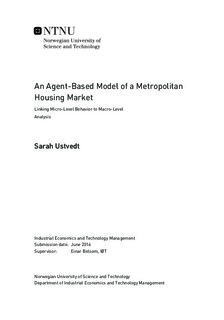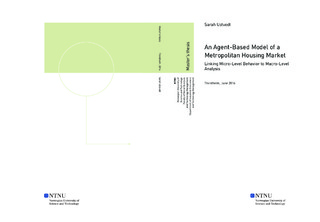| dc.description.abstract | In this thesis, an agent-based model (ABM) of a metropolitan housing market is developed. ABMs are computational models simulating interactions between autonomous agents, and are built bottom-up by defining these agents on the micro-level. The ABM of this thesis is intended to match the market of the Norwegian capital, Oslo, with behavioral rules governed by historical data. The main agents of the model are households who engage in decisions such as moving and purchasing dwellings as investments. Exogenous variables of the model include the interest and unemployment rates, housing construction and immigration. Endogenous variables, which emerge as a result of agent interactions, are for instance the housing price, debt of households and home-ownership rate.
An important component of the ABM presented in this work is the defined market protocol, where bidding rounds are held in order to clear the market. Further, households are assigned ordinal housing preference functions, which are applied to determine the sequence of bidding rounds the households participate in. Compared to the majority of literature on ABMs of the housing market, where all households prefer the same dwellings, this provides the model with more heterogeneous agents. Another feature of the ABM is that it is spatial. By applying Geographical Information System (GIS) data of Oslo, the dwellings in the model are placed in a 2-dimensional grid with borders representing the city's districts. This makes it possible to analyse price development in different geographical areas of the city.
The model is shown to generate output conforming well to historical data. Interesting observations include a higher growth of prices in central districts than in the suburbs, attributed to the high immigration of young households.
Three different counterfactual experiments are performed, in order to evaluate the effect of policy modifications and shocks to the model. First, tightening of the bank's mortgage extension policy through debt-to-income (DTI) and loan-to-value (LTV) limits is shown to have a stagnating impact on price development. Further, removing tax deduction of interest expenses yields a reduced price growth. Finally, an experiment testing how the market would respond to an interest rate shock is performed. A significant fall in prices and reduction in the growth of household debt is shown to be among the results. | |

